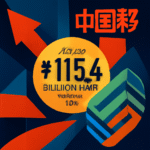Key Points
- China’s State Council approved a new “Action Plan for Green and Low-Carbon Development in Manufacturing (2025-2027)” to accelerate the shift towards sustainable industry.
- Key aspects of the Green Manufacturing Plan include boosting green tech adoption, transforming traditional industries, promoting resource efficiency, and strengthening the green ecosystem.
- China is enhancing its ecological protection compensation mechanism, aiming for wider coverage, clearer rules, and bringing in social capital, based on the principle “who pollutes, who governs; who protects, who benefits.”
- Amendments to the Food Safety Law focus on a more scientific, proactive, and full-chain regulatory system with intensified local oversight and strict punishment for violations.
China is making some bold moves to green up its manufacturing sector, strengthen ecological safeguards, and tighten food safety regulations, signaling key shifts for businesses and investors operating in the region.
On May 23, 2025, a pivotal State Council executive meeting, led by Premier Li Qiang, signed off on an ambitious “Action Plan for Green and Low-Carbon Development in Manufacturing (202ers to “Key Pillars of the Green Manufacturing Plan:
- Accelerating Green Tech: A major push for innovation, promotion, and widespread application of advanced green technologies. This is about laying a solid green foundation for what’s being termed “new industrialization.”
- Transforming Traditional Industries: Expect a deep green makeover for legacy sectors. This will involve deploying advanced equipment and processes, likely tying into broader policies like large-scale equipment renewal initiatives. Think major upgrades in key industries.
- Boosting Emerging Industries: For newer sectors, the goal is a high-starting-point for green development. This means more support for clean energy and green products.
- Resource Efficiency: A strong emphasis on enhancing resource recycling levels – turning waste into worth.
- Strengthening the Ecosystem: This includes fostering breakthroughs in key common technologies, beefing up standards in critical areas, fine-tuning relevant policies, and building out a robust green manufacturing and service system to help businesses transition.
For techies, founders, and investors, this signals a wave of opportunities in green technologies, sustainable solutions, and eco-friendly manufacturing processes.
Companies that can provide expertise or technology for these green upgrades will likely find a receptive market.

Boosting Mother Nature’s Paycheck: Stronger Ecological Protection Compensation
China is also doubling down on its commitment to environmental protection by enhancing its transverse ecological protection compensation mechanism.
Sounds complex, but the idea is simple: create a fair system where costs and benefits of ecological protection are shared, fostering cooperative governance across regions.
What They’re Aiming For:
- Wider Coverage: Expanding the reach of these compensation schemes.
- Clearer Rules: Defining rights and responsibilities more precisely.
- Diverse Methods: Using a variety of approaches for compensation.
- Better Governance: Making the whole system more efficient.
- Win-Win Scenarios: Encouraging positive interactions between areas that supply ecological “products” (like clean water or air) and areas that benefit from them.
- Expanding coverage
- Making rules clearer
- Utilizing diverse compensation methods
- Improving governance efficiency
- Fostering win-win interactions between ecological supply and benefit areas
The focus will initially be on the main streams of major rivers, with plans to steadily expand to other ecological factors like forests, grasslands, and even the atmosphere.
A core principle here is “who pollutes, who governs; who protects, who benefits.”
Look out for improved incentive and constraint policies designed to draw more social capital into ecological civilization construction.
This could open doors for ESG investors and funds focused on environmental impact projects.

Find Top Talent on China's Leading Networks
- Post Across China's Job Sites from $299 / role
- Qualified Applicant Bundles
- One Central Candidate Hub
Your First Job Post Use Checkout Code 'Fresh20'

Food Safety Overhaul: Building a More Proactive System
Food safety is a paramount concern, and China is moving to amend its “Food Safety Law of the People’s Republic of China.”
The draft is now heading to the Standing Committee of the National People’s Congress for deliberation.
Key Shifts in Food Safety Regulation:
- Science-Backed Standards: A push for a more scientific and rigorous food safety standard system, with a special focus on mandatory standards.
- Prevention First: A significant shift in the food safety governance model towards proactive prevention, rather than just reactive measures.
- Full-Chain Regulation: Strengthening supervision across the entire food supply chain, from farm to fork.
- Localized Oversight: Moving the regulatory focus downwards for stricter daily supervision and inspections at the ground level.
- Targeted Crackdowns: Conducting specific campaigns in key high-risk areas.
- Zero Tolerance: Strengthening the handling of supervision and spot check results, with strict, non-tolerant punishment for any problems found.
The aim is to continuously improve the food safety system, ensuring what’s on the plate is safe for life and health.
For businesses in the food and beverage sector, this means staying ahead of evolving standards and focusing on robust quality control systems.
These comprehensive policy updates highlight China’s strategic direction towards a more sustainable and responsibly governed economy.
For those in tech, investment, and marketing, understanding these shifts is crucial for navigating the opportunities and challenges in one of the world’s most dynamic markets as it embraces a greener future and stricter safety standards.
References
- 李强主持召开国务院常务会议 审议通过《制造业绿色低碳发展行动方案(2025—2027年)》等 – 新华网 (Li Qiang presides over State Council executive meeting, reviews and approves “Action Plan for Green and Low-Carbon Development in Manufacturing (2025-2027)”, etc. – Xinhua Net)
- China to spend 1 trillion yuan on equipment upgrades to boost consumption, investment – South China Morning Post (This article provides context on broader equipment upgrade initiatives which may align with the manufacturing green plan.)
- China ramps up efforts to boost ecological protection compensation – China Daily (This article offers background on the development of ecological protection compensation mechanisms.)





![China's MIIT Signals Major Push for General and Industry-Specific AI Large Models [FreshFromChina]](https://freshfromchina.com/wp-content/uploads/2025/05/China_s_MIIT_Signals_Major_Push_for_General_and_Industry-Specific_AI_Large_Models____FreshFromChina-150x150.png)